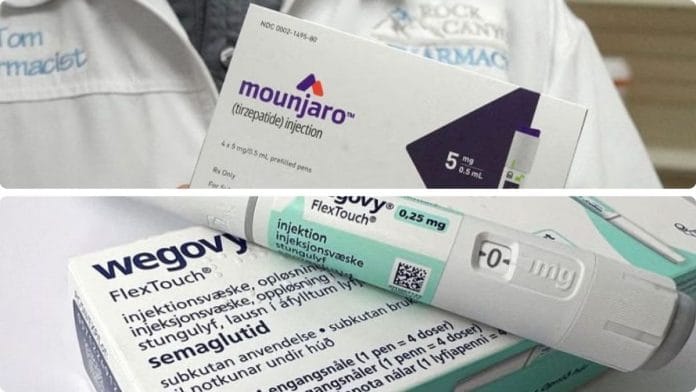New Delhi: A head-to-head clinical trial comparing two globally popular obesity drugs—tirzepatide and semaglutide—revealed that the former, launched in India in March, proved significantly more effective than the latter in reducing both weight and waist circumference after 72 weeks of treatment.
Tirzepatide, developed by US-based pharmaceutical giant Eli Lilly and Company and sold under the brand name Mounjaro, had already made a global impact prior to its Indian debut on 20 March.
A less potent version of semaglutide, by Danish drugmaker Novo Nordisk, in pill form under the brand name Rybelsus, has been available in India since January 2022. However, Ozempic and Wegovy—the injectables in higher dosage strengths—have yet to be rolled out in the country.
Both medications were prescribed as weekly injections for patients clinically classified as obese, and were recommended alongside a controlled diet and regular physical activity.
Lilly announced Monday that complete data from its phase 3b, open-label clinical trial (a trial in which both researchers and participants are not kept in the dark about which treatment is being administered), SURMOUNT-5, demonstrated the safety and efficacy of tirzepatide in adults with obesity (BMI of 30 or higher) or those overweight (BMI between 25 and 29.9) with at least one associated medical condition—excluding diabetes.
According to Lilly, participants administered tirzepatide saw an average weight reduction of 20.2 percent, while those on semaglutide experienced a 13.7 percent loss—indicating a 47 percent greater relative weight loss for the former, based on the treatment-regimen estimand at 72 weeks.
The findings, published in The New England Journal of Medicine Sunday, noted that participants on tirzepatide lost an average of 22.8 kg, while those on semaglutide shed around 15 kg.
Tirzepatide also outperformed semaglutide in all weight reduction benchmarks: 64.6 percent of individuals on tirzepatide achieved at least a 15 percent body weight loss compared to 40.1 percent on semaglutide.
In terms of waistline impact, those on tirzepatide recorded an average reduction of 7.2 inches, whereas semaglutide users saw a decrease of 5.1 inches.
“Obesity is a chronic disease that requires comprehensive management, and Lilly is committed to supporting people with obesity and enhancing the standard of care in obesity management in India,” said Winselow Tucker, company president and general manager for India.
He added that results from the SURMOUNT-5 trial provide robust evidence supporting tirzepatide as an effective option for obesity management in the country.
Tirzepatide is a dual GIP (glucose-dependent insulinotropic polypeptide) and GLP-1 (glucagon-like peptide-1) receptor agonist, while semaglutide functions as a mono GLP-1 receptor agonist. Both GIP and GLP-1 are natural incretin hormones (gut hormones that stimulate a decrease in blood glucose levels) found in brain regions that regulate appetite. These agents work by lowering caloric intake, primarily by influencing appetite control mechanisms.
In response to a query by ThePrint last week, Novo Nordisk confirmed it would launch Wegovy in India this year, which delivers the full therapeutic strengths of semaglutide for complete obesity and weight management.
“It also provides remarkable cardiovascular benefits and more, making it an impactful option for obesity care,” Novo Nordisk said.
According to the largest-ever Indian obesity survey conducted jointly by the Indian Council of Medical Research (ICMR) and Madras Diabetes Research Foundation (MDRF) in 2023, 254 million Indians—or 28.6 percent of the population—had generalised obesity. The same survey estimated that 351 million people, or 39.5 percent of the population, were affected by abdominal obesity.
Over recent decades, evidence linking a high BMI to a number of non-communicable diseases—including hypertension, diabetes, dyslipidaemia (abnormal levels of lipids or lipoproteins in the blood), and cancer—has grown, with obesity now widely recognised as a leading contributor to mortality.
Also Read: New subtype of diabetes found in India could change how rare forms of disease are treated
Tirzepatide also slightly safer than semaglutide
The SURMOUNT-5 trial ran for 72 weeks and was conducted across multiple centres. It was a randomised, open-label, phase 3b study comparing the efficacy and safety of tirzepatide with semaglutide in adults who were obese or overweight and had one or more associated comorbidities: hypertension, dyslipidaemia, obstructive sleep apnoea (sleep disorder in which there are repeated pauses in breathing while sleeping), or cardiovascular disease—but without diabetes.
All participants received counselling on reducing caloric intake and increasing physical activity. A total of 751 participants across the US and Puerto Rico were randomised in a 1:1 ratio to receive either tirzepatide (10 mg or 15 mg) or semaglutide (1.7 mg or 2.4 mg), depending on their maximum tolerated dose.
Among those receiving tirzepatide, 89.3 percent were administered at least one dose of 15 mg. For semaglutide, 92.8 percent received at least one dose of 2.4 mg.
Lilly stated that tirzepatide’s safety profile in this trial aligned with findings from previous SURMOUNT studies.
Most adverse events reported were gastrointestinal in nature and were largely mild to moderate in severity.
During the trial, 6.1 percent of participants on tirzepatide discontinued the drug due to adverse events, compared to eight percent of those taking semaglutide.
“However, the study was not powered to compare the safety and tolerability of tirzepatide and the safety and tolerability of semaglutide,” Eli Lilly clarified in a statement.
These classes of anti-obesity and diabetes medications have been associated with side effects such as nausea, vomiting, and bloating. In rare instances, the drugs have been linked to gastroparesis, a condition in which intestinal muscles fail to move food efficiently, resulting in delayed digestion.
A senior obesity researcher at the All India Institute of Medical Sciences (AIIMS), Delhi, who wished not to be named, told ThePrint that the new findings marked a turning point in the treatment of obesity.
“But it should be remembered that these medicines should only be taken under expert guidance and supervision,” he stressed.
(Edited by Radifah Kabir)
Also Read: Pune-based firm receives major international grant to accelerate development of Nipah virus vaccine






